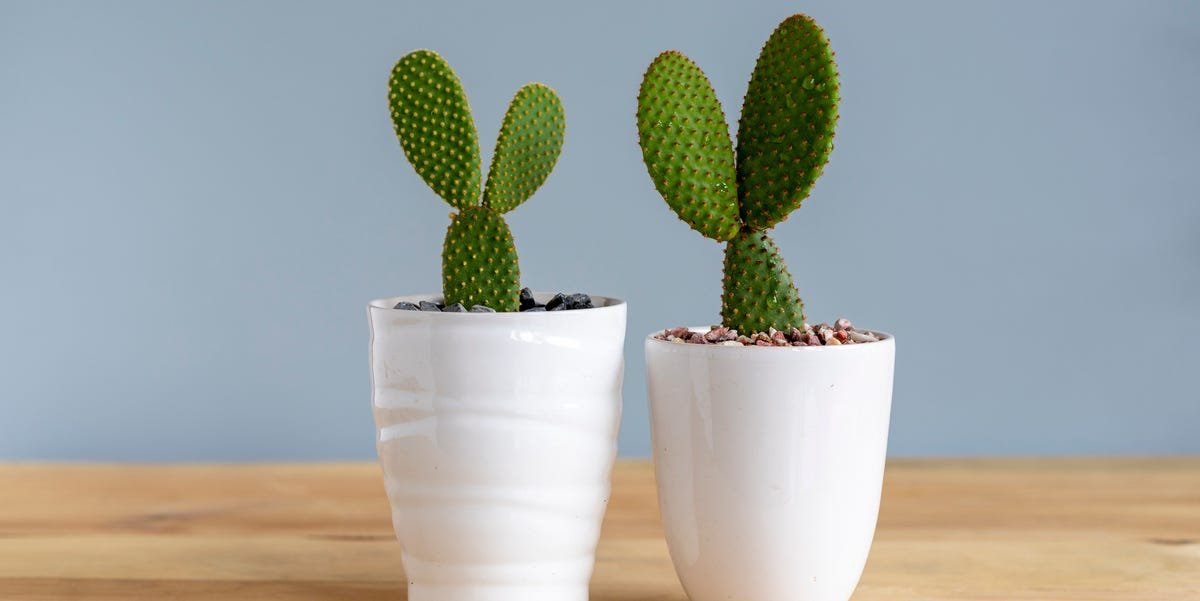[ad_1]
If you’re seeking a new, low-maintenance addition to your houseplant collection, consider a cactus. The bunny ears cactus, with its thick round or oval pads resembling a rabbit’s upright ears, is an especially delightful variety. As part of the Cactaceae family, these cacti are perfect for those who tend to be forgetful—their fleshy pads retain water, allowing them to thrive for extended periods without needing to be watered.
Native to Northern Mexico to the deserts of Arizona, the bunny ears cactus (Opuntia microdasys) is a slow-growing plant like most other cacti. They’re sometimes also called angel’s wings or polka dot cactus. Outdoors, bunny ears can reach two to three feet tall and four to five feet wide after a couple of decades. They also can be grown in containers and overwintered indoors in cold climates. Indoors, they tend to stay smaller and remain a tabletop plant for many years. They also rarely flower indoors.
Despite the cuddly name and cottony appearance of the dots (called glochids), these cacti are extremely prickly! There are three varieties with either silvery-white, golden, or cinnamon-colored dots. Each dot actually is a patch of small, super-sharp bristly spines that easily lodge in the skin. For this reason, always wear heavy gardening gloves when handling this plant—you’ll also want to avoid this plant if you have toddlers or nosy pets at home.
Here’s everything you need to know about how to grow and care for a bunny ears cactus.
How to Care for Bunny Ears Cactus
Bunny ears are not difficult to grow if you give them the right conditions. The biggest challenge is not overwatering them, keep them on the drier side.
Light and Temperature
The bunny ears cactus likes full sun, which is considered six or more hours of direct sunlight per day. The more full sun, the happier they are and the faster they will grow.
Indoors, you may need to supplement natural sunlight with an LED grow light. Insufficient light will cause your plant to get long and stretchy-looking instead of developing its cute bunny-shaped form. This cactus also prefers temperatures higher than 70 degrees Fahrenheit with low humidity levels.
Soil
Use a fast-draining potting mix labeled specifically for cacti. These are typically sandy or gritty in texture to stand in for the plant’s native environment.
Water
Bunny ears will not tolerate sitting in water, so make sure your pot has drain holes and that it doesn’t get too soggy. Native to the desert, this plant can go long periods—even months— without watering. It’s always a good idea to allow your bunny ears cactus to dry out completely before watering again.
It will develop root rot if you water too frequently, so always poke your finger in to test or stick a chopstick down into the potting mix to see if it comes out with any soil sticking to it. If so, it is still too wet; test again in a few days.
Fertilizer
Because this plant is accustomed to poor soils, it’s not entirely necessary to fertilize. But you can give it a little boost by fertilizing once a year in spring with a cactus fertilizer.
Where to Grow Bunny Ears Cactus
How to Repot a Bunny Ears Cactus
As a slow-grower, this plant will not need to be repotted as frequently as other houseplants, such as pothos or philodendrons. When it does outgrow its pot or begins to tip over because it has become top-heavy, wear gloves and size up into a slightly larger pot (two to three inches larger). Use a cacti potting mix, but try to keep as much of the original potting medium around the roots as possible to prevent disturbing them.
How to Propagate a Bunny Ears Cactus
Like most cacti, bunny ears are easy to propagate. Break off one of the pads from the mother plant and let it dry out or callus over for a day or so. Then poke the pad cut-side down an inch into the potting mix in a new pot.
Give the pot direct sunlight or place it under a grow light. After a few weeks, the pad should root. At this point, you can water lightly. You also can place several pads in the same pot to make a fuller plant.
Common Pests and Diseases
Overwatering is the most common problem with most cacti, including bunny ears. It may develop brown spots and collapse if it receives too much water.
Bunny ears cactus also is subject to pests such as aphids and mealybugs. Treat with neem oil as soon as you notice an infestation.
Are Bunny Ears Cactus Toxic to Pets?
According to the ASPCA, bunny ears cactus are not toxic to pets. However, the big risk is your pet getting a spine in a nose, paw, or other sensitive area. Keep this plant away from pets, and if your pet has made contact with it, call your vet ASAP for guidance.
[ad_2]
Source link
Share this content:



